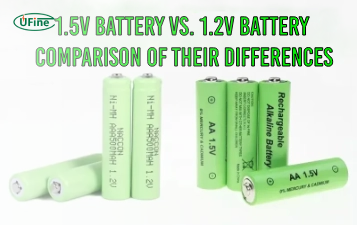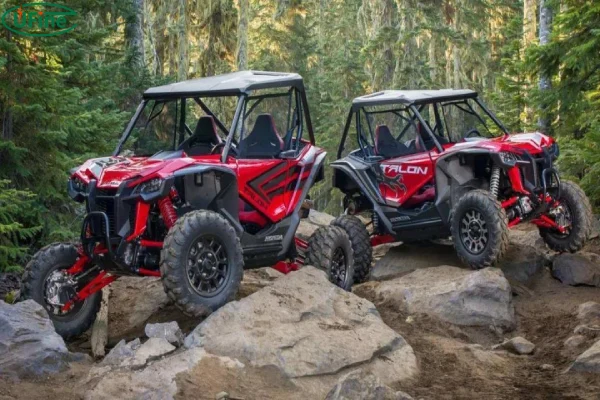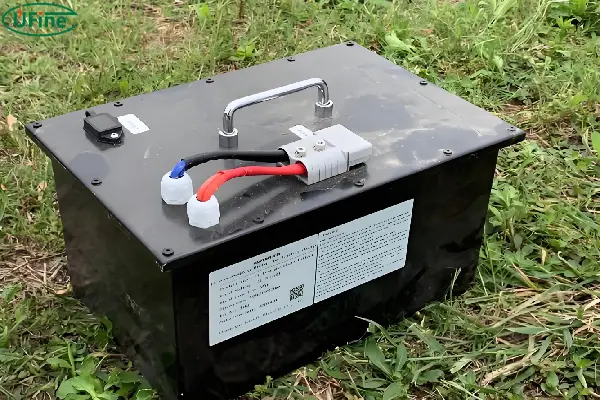
UTVs, or Utility Terrain Vehicles, are the ultimate off-road machines, capable of tackling rugged trails, hauling cargo, and providing thrilling adventures. But just like any powerful machine, a UTV needs a reliable power source to perform at its best. That power source is its battery.
Choosing the right UTV battery isn’t just about starting the engine; it’s about ensuring consistent performance, maximizing your riding time, and keeping your adventures running smoothly. This comprehensive guide will delve into the world of UTV batteries, exploring the different types, key parameters, and maintenance tips to help you make an informed decision and unlock the full potential of your UTV.
Part 1. What’s the UTV battery
While the most obvious function of a UTV battery is to start the engine, its role extends far beyond that. A strong battery powers your UTV’s electrical system, ensuring that everything from your headlights and taillights to your gauges and accessories function properly. It also plays a crucial role in powering your winch, if you have one, providing the necessary force to pull yourself out of tricky situations.
Part 2. UTV battery structure and principle
Most UTV batteries are lead-acid batteries, which utilize a chemical reaction to generate electricity. Here’s a simplified explanation of their structure and principle:
-
Structure: A lead-acid battery consists of several lead plates immersed in an electrolyte solution, typically sulfuric acid. The plates are arranged in alternating positive and negative pairs, separated by a porous separator.
-
Principle: When the battery is discharged, a chemical reaction occurs between the lead plates and the electrolyte. This reaction releases electrons, creating an electrical current that flows from the negative terminal to the positive terminal. When the battery is charged, the chemical reaction reverses, storing energy in the battery.
Part 3. UTV battery types
UTV batteries come in a variety of types, each with its own strengths and weaknesses. Choosing the right type depends on your specific needs, riding conditions, and budget. Here’s a closer look at the most common UTV battery types:
-
Lead-Acid Batteries: These are the most traditional and widely available UTV batteries, known for their affordability and reliability. They’re also relatively easy to maintain, with readily available replacement parts. However, lead-acid batteries have several drawbacks:
- Weight: They’re heavier than other battery types, which can impact your UTV’s handling and performance, especially on steep inclines.
- Lifespan: They have a shorter lifespan compared to newer battery technologies, requiring more frequent replacements.
- Maintenance: They require regular maintenance, including checking the electrolyte level and topping it off with distilled water.
- Safety: They can leak acid if mishandled, requiring careful handling and storage.
-
AGM (Absorbed Glass Mat) Batteries: These batteries are an improvement over standard lead-acid batteries, using a fiberglass mat to absorb the electrolyte. This design offers several advantages:
- Leak-Proof: They’re virtually leak-proof, reducing the risk of spills and corrosion.
- Vibration Resistance: They’re more resistant to vibration, making them ideal for off-road use.
- Longer Lifespan: They have a longer lifespan than standard lead-acid batteries, reducing the frequency of replacements.
- Performance: They offer better performance in cold weather and have a higher discharge rate, allowing for more power delivery.
-
Gel Batteries: These batteries take the leak-proof design of AGM batteries a step further, using a gel-like electrolyte. This offers even greater protection against spills and leaks, making them ideal for harsh environments. Here are their key features:
- Extreme Durability: They’re incredibly durable and resistant to vibration, making them perfect for off-road use.
- Deep Cycle Capability: They have excellent deep-cycle capability, meaning they can be discharged and recharged repeatedly without significant damage. This is particularly important for UTVs used for long rides or off-grid adventures.
- Longer Lifespan: They have a longer lifespan than both standard lead-acid and AGM batteries, reducing the frequency of replacements.
-
Lithium-Ion Batteries: These batteries represent the cutting edge of battery technology, offering significant advantages over traditional lead-acid batteries:
- Lightweight: They’re significantly lighter than lead-acid batteries, improving your UTV’s handling and performance.
- High Power Density: They have a higher power density, meaning they can store more energy in a smaller space. This translates to longer run times and better performance.
- Longer Lifespan: They have a much longer lifespan than lead-acid batteries, reducing the frequency of replacements and saving you money in the long run.
- Faster Charging: They charge faster than lead-acid batteries, making it easier to get back on the trail quickly.
However, lithium-ion batteries also come with some drawbacks:
- Cost: They’re more expensive than traditional lead-acid batteries.
- Sensitivity: They’re more sensitive to extreme temperatures, requiring careful storage and handling.
- Availability: They’re not as widely available as lead-acid batteries, making it more challenging to find replacement parts.
Part 4. Key parameters to consider
Choosing the right UTV battery requires understanding several key parameters that determine its performance and suitability for your needs. Here’s a breakdown of the most important factors:
-
Cold Cranking Amps (CCA): This rating measures the battery’s ability to start the engine in cold weather. A higher CCA rating means the battery can deliver more power in frigid conditions, ensuring a smooth start even on the coldest days. The CCA rating you need will depend on your UTV’s engine size and the climate you typically ride in.
-
Reserve Capacity (RC): This rating measures how long the battery can power the vehicle’s electrical system with the engine off. A higher RC rating means the battery can provide power for longer periods, essential for situations where you need to run accessories or use your winch without the engine running. The RC rating you need will depend on how often you use your winch or accessories and how long you typically ride without stopping.
-
Voltage: UTV batteries typically operate at 12 volts, but some higher-performance models may use a 24-volt system. Make sure the battery you choose matches the voltage requirements of your UTV.
-
Dimensions: The battery must fit securely in your UTV’s battery compartment. Measure the dimensions of your existing battery or check your UTV’s manual for the recommended battery size.
-
Weight: Consider the weight of the battery, especially if you’re carrying it frequently or if you need to lift it into your UTV. Lithium-ion batteries are significantly lighter than lead-acid batteries, offering a considerable advantage in this regard.
Part 5. What is the best UTV battery?
The “best” UTV battery doesn’t exist in a vacuum; it depends on your individual needs and priorities. Here’s a breakdown of the best scenarios for each battery type:
-
Lead-Acid Batteries: If you’re on a tight budget and don’t need the most advanced features, a standard lead-acid battery is a solid choice. They’re readily available and easy to maintain, but keep in mind their shorter lifespan and weight.
-
AGM Batteries: If you prioritize leak-proof performance, vibration resistance, and longer lifespan, AGM batteries are a great option. They offer a good balance of features and affordability, making them a popular choice for many UTV owners.
-
Gel Batteries: If you ride in harsh conditions or frequently use your UTV for long rides or off-grid adventures, gel batteries offer exceptional durability, deep-cycle capability, and extended lifespan. They’re a premium choice for demanding users.
-
Lithium-Ion Batteries: If you prioritize lightweight performance, high power density, and extended lifespan, lithium-ion batteries are the top choice. They offer the best overall performance but come at a higher price point.
Part 4. How to find the best battery for your UTV?
AGM VS Lithium VS Lead-Acid Battery: Comprehensive Comparison
Choosing the right UTV battery is a crucial decision that can significantly impact your riding experience. Here’s a step-by-step guide to help you make the best choice:
-
Consult Your UTV’s Manual: The owner’s manual for your UTV will provide the recommended battery type, voltage, CCA, and RC ratings for your specific model. This is the most reliable starting point for your battery selection.
-
Consider Your Riding Conditions: Think about the typical climate you ride in and how often you use your winch or accessories. If you ride in cold weather, you’ll need a battery with a higher CCA rating. If you use your winch frequently or ride for long periods without stopping, you’ll need a battery with a high RC rating.
-
Assess Your Budget: UTV batteries range in price, with lead-acid batteries being the most affordable and lithium-ion batteries being the most expensive. Set a budget before you start shopping and focus on batteries that fit within your price range.
-
Compare Features and Warranty: Once you’ve narrowed down your choices, compare the features and warranty offered by different manufacturers. Look for batteries with a good warranty and a reputation for quality and reliability.
-
Choose a Reputable Brand: Select a battery from a reputable brand known for producing high-quality, durable batteries. Look for brands with a strong track record and positive customer reviews.
Part 5. Maintenance and charging tips
Proper maintenance and charging are essential for extending the lifespan of your UTV battery and ensuring optimal performance. Here are some key tips:
-
Keep the Battery Terminals Clean: Corrosion on the battery terminals can prevent a good electrical connection, reducing power delivery and potentially causing damage to your battery. Regularly clean the terminals with a wire brush and a baking soda solution to remove any corrosion buildup.
-
Check the Electrolyte Level (Lead-Acid Batteries Only): If you have a standard lead-acid battery, check the electrolyte level regularly. The electrolyte level should be above the plates. If it’s low, add distilled water to top it off. Never add anything other than distilled water to a lead-acid battery.
-
Charge the Battery Regularly: Charge your battery fully after each use, especially if you’re not using your UTV for extended periods. A fully charged battery will last longer and provide better performance.
-
Use the Right Battery Charger: Use a battery charger designed for your battery type. Using the wrong charger can damage your battery and shorten its lifespan.
-
Store the Battery Properly: If you’re storing your UTV for an extended period, remove the battery and store it in a cool, dry place. A fully charged battery will store better than a partially charged battery.
Part 6. Conclusion
Choosing the right UTV battery is an important decision that can significantly impact your riding experience. By understanding the different types of batteries, their key parameters, and proper maintenance practices, you can ensure that your UTV has the power it needs to tackle any adventure.
Related Tags:
More Articles

1.5V Battery Vs. 1.2V Battery: Comparison of Their Differences
Compare 1.2V vs 1.5V batteries: voltage, usage, rechargeability. Best for remotes, toys, cameras. Discover which AA battery suits your device.
Recommended 10 Best Batteries For Smoke Detectors
Discover the best batteries for smoke detectors in 2025. Compare top 10 9V and AA options for long-lasting, leak-proof, and reliable smoke alarm power.
Triple A Battery Voltage: Everything You Need to Know
Learn how many volts are in a triple A battery (1.5V vs 1.2V), see AAA battery voltage chart, and compare chemistry, testing, and lifespan for 2025 devices.
9V vs AA Batteries for Fire Alarm: Which One Should You Use?
Compare 9V and AA batteries for smoke detectors. Learn which type provides better lifespan, voltage, and cost efficiency to keep your fire alarms reliable.
Flashlight Battery Size: Types, Choosing Tips and FAQs
Explore flashlight battery sizes with an easy chart. Learn what batteries small flashlights use and how to pick 18650, 26650, 14500, or CR123A cells.




